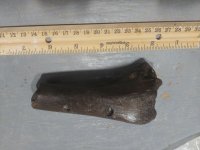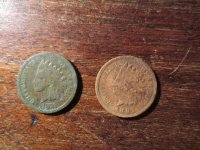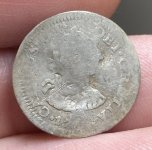You are using an out of date browser. It may not display this or other websites correctly.
You should upgrade or use an alternative browser.
You should upgrade or use an alternative browser.
Fossil horse bone
- Thread starter newnan man
- Start date
Vermont treasure hunter
Hero Member
- Jul 7, 2020
- 504
- 774
- Detector(s) used
- An old radio shack, simplex
- Primary Interest:
- All Treasure Hunting
What do you mean horses became extinct thousands of years ago? They are still around today.
Red-Coat
Gold Member
What do you mean horses became extinct thousands of years ago? They are still around today.
Horses originally evolved in North America (the wild horse Equus ferus and several species of stilt-legged horse - notably Equus francisci and Equus calobatus) and progressively spread to Eurasia. But they became extinct is North America at the end of the last ice age around 10,000 to 12,000 years ago.
They didn’t reappear (as domesticated horses) until 1519 via Cortés on the Yucatan Peninsula in Mexico and a little later via De Coronado in New Mexico and De Soto in Florida around 1539-1540. Even then it took until the 1700s for them to spread throughout the North American continent. Bones from horses re-introduced by the Spanish conquistadores won't be fossilized or heavily mineralised.
That's a great find, newnam man.
Vermont treasure hunter
Hero Member
- Jul 7, 2020
- 504
- 774
- Detector(s) used
- An old radio shack, simplex
- Primary Interest:
- All Treasure Hunting
Horses originally evolved in North America (the wild horse Equus ferus and several species of stilt-legged horse - notably Equus francisci and Equus calobatus) and progressively spread to Eurasia. But they became extinct is North America at the end of the last ice age around 10,000 to 12,000 years ago.
They didn’t reappear (as domesticated horses) until 1519 via Cortés on the Yucatan Peninsula in Mexico and a little later via De Coronado in New Mexico and De Soto in Florida around 1539-1540. Even then it took until the 1700s for them to spread throughout the North American continent. Bones from horses re-introduced by the Spanish conquistadores won't be fossilized or heavily mineralised.
That's a great find, newnam man.
Thank you red coat! Was a little confused there! Thanks for clarifying!
Older The Better
Silver Member
- Apr 24, 2017
- 3,155
- 5,893
- Detector(s) used
- Whites Eagle Spectrum
- Primary Interest:
- All Treasure Hunting
If I remember right early on they used to be very small as well, like a dog or goat size. Like the teeth marks adds another layer to its story
Fat
Bronze Member
- Oct 22, 2020
- 2,191
- 6,887
- Detector(s) used
- I took the battery out because I like my bacon crispy
- Primary Interest:
- Other
Check out “Agate springs fossil beds” and “ashfall fossil bed. Both have horse and camels. I have family that ranch around agate springs. It is funny to see a horse skull the size of your hand. Agate also has some of the best artifacts from the days of fort Rob. Thats the fort were an indian guard stabbed crazy horse and he died soon after.
Top Member Reactions
-
 2149
2149 -
 982
982 -
 948
948 -
 944
944 -
 844
844 -
 798
798 -
 796
796 -
 684
684 -
 559
559 -
 548
548 -
 482
482 -
 476
476 -
 456
456 -
O
444
-
 439
439 -
 433
433 -
 422
422 -
 407
407 -
 375
375 -
 365
365
Users who are viewing this thread
Total: 2 (members: 0, guests: 2)







